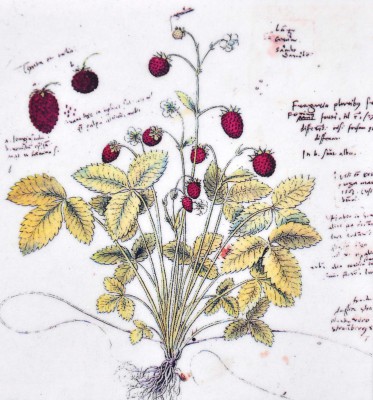It’s an odd coincidence that in Richard III (written in 1592) and in Henry V (written in 1599) Shakespeare links the same character with strawberries. Or is it?
Ely Palace or Ely House, the London residence of the Bishops of Ely from 1290 to 1772, stood in the Holborn area of London. It was purchased by John de Kirkby in 1280. He was appointed Bishop of Ely in 1286 and on his death in 1290 he left the estate to the see of Ely.
 St Etheldreda’s Church in Ely Place is the former private chapel of the Bishops of Ely. It is the only surviving building in London from the reign of Edward I (1239–1307), although it was badly damaged during World War II. St Etheldreda, a seventh-century queen and nun, was the saint in whose name Ely Cathedral was founded.
St Etheldreda’s Church in Ely Place is the former private chapel of the Bishops of Ely. It is the only surviving building in London from the reign of Edward I (1239–1307), although it was badly damaged during World War II. St Etheldreda, a seventh-century queen and nun, was the saint in whose name Ely Cathedral was founded.
The gardens of St Etheldreda were said to produce the finest strawberries in London and a Strawberry Fayre is still held here every June. In Shakespeare’s Richard III, the as yet uncrowned Gloucester tells the Bishop of Ely:
“My Lord of Ely, when I was last in Holborn,
I saw good strawberries in your garden there.
I do beseech you send for some of them”.
The strawberries are fetched and Richard eats them. A little while later he returns in a foul mood, claiming that his arm has withered. According to Sir Thomas More’s History of King Richard III – written a hundred years after Richard’s death – the incident actually took place:
“And soon, after one hour, between ten and eleven he returned into the chamber among them, all changed, with a wonderful sour angry countenance, knitting the brows, frowning and froting [chafing] and gnawing on his lips… And therewith he plucked up his doublet sleeve to his elbow upon his left arm, where he showed a werish [deformed] withered arm and small, as it was never other.”
Amy Licence, writing in “Was the downfall of Richard III caused by a strawberry?” (New Statesman 31 August 2013), says the dish of strawberries may have been responsible for causing Richard’s arm to appear withered:
“The allergic reactions caused by the proteins in strawberries can produce tingling limbs, breathing difficulties and red, puffy, itchy skin. These symptoms usually occur within two hours of eating the fruit, which is compatible with the timescale of the meeting… Internal distress, breathing difficulties following the closing of bronchial tubes and congestion can follow. Sufferers also experience itching, with limbs becoming red, puffy and blighted… It is quite possible that Richard had a latent allergy to strawberries which emerged with the first crop that June, causing the sudden physical responses in his body.”
 Strawberries take on a different meaning in Shakespeare’s Henry V, where a different Bishop of Ely says of the newly crowned king:
Strawberries take on a different meaning in Shakespeare’s Henry V, where a different Bishop of Ely says of the newly crowned king:
“The strawberry grows underneath the nettle,
And wholesome berries thrive and ripen best
Neighbor’d by fruit of baser quality…”
At first sight this seems to be a positive comment on Prince Hal’s transformation from a reprobate (his character in both parts of Henry IV) into a king. But Shakespeare’s audiences might have heard an echo of another sense. In Essaying Shakespeare (2009), Karen Newman points out that:
“In the Renaissance, strawberries signified virtue or goodness but also hypocritical virtue as symbolized by the frequently occurring design and emblem of a strawberry plant with an adder hiding beneath its leaves.”
It was one of Shakespeare’s contemporaries, the Cambridge physician Dr William Butler (1536-1617), who wrote, “Doubtless God could have made a better berry, but doubtless God never did.” The delicate wild strawberry (Fragaria) as opposed to the cultivated garden strawberry is what Butler meant, but surely that which we call a strawberry, by any other name would taste as sweet!